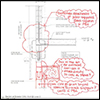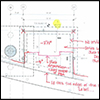 At Powers Brown Architecture, we strive to be an industry leader in the practice of architecture, and we recognize that practice does not stop with award-winning design – that is just the beginning. The architecture industry has evolved over the past decades – where architects were once the singular agent of design execution, now architects also act as coordinators of a complex matrix of engineers, consultants, trade experts and builders. This new normal requires architects to ensure that we pay close attention to the quality of our designs and construction documents since there are so many people involved with the design vision execution. As a firm, we never rely on the “means and methods” philosophy for document development. We recognize that quality documentation is critical to ensuring that the design is carried from concept to construction, and our internal quality program is the most developed and defined of any in the architecture industry. As the first architecture firm to become members of the Construction Quality Executives Council (CQEC), we have the unique capability of testing our practice systems with some of the largest and most accomplished general contractors in the US to verify their efficacy.
At Powers Brown Architecture, we strive to be an industry leader in the practice of architecture, and we recognize that practice does not stop with award-winning design – that is just the beginning. The architecture industry has evolved over the past decades – where architects were once the singular agent of design execution, now architects also act as coordinators of a complex matrix of engineers, consultants, trade experts and builders. This new normal requires architects to ensure that we pay close attention to the quality of our designs and construction documents since there are so many people involved with the design vision execution. As a firm, we never rely on the “means and methods” philosophy for document development. We recognize that quality documentation is critical to ensuring that the design is carried from concept to construction, and our internal quality program is the most developed and defined of any in the architecture industry. As the first architecture firm to become members of the Construction Quality Executives Council (CQEC), we have the unique capability of testing our practice systems with some of the largest and most accomplished general contractors in the US to verify their efficacy.
Our quality program at Powers Brown Architecture was developed and is led by Jeanette Shaw, AIA, LEED AP. Email me at shaw@powersbrown.com
![]()
PRESENTATION
Architecture practices have placed their focus on design, innovation, and sustainability yet have neglected the importance of proper detailing and documentation to promote these strategies. This program describes the reasons architects deviated from the basics and creates simple strategies for a hard restart. Implementing a proper Quality Program is the key to succeeding in not only affirming the design but also in protecting the Architecture practice from the costs of rework and risk management concerns.
PRESENTATION
This presentation was created to provide a collaborative recommendation and study on the value of constructability reviews performed both during the design process and during a preconstruction process with the General Contractor. The differences between design reviews and constructability reviews are highlighted. The presentation also discusses the obstacles to doing proper constructability reviews with certain delivery methods and proposes solutions to overcoming these obstacles.
PRESENTATION
A good quality control program is critical to the effective growth of any architecture practice. By recognizing the importance of quality processes, a practice can ensure that their staff is properly trained, their documents are properly developed, and that their place in the market is strong and respected.
![]()
PRESENTATION
This presentation was created to provide guidelines for encouraging clients to hire companies that have established quality programs over firms that do not value quality. Objectives included identifying metrics that can drive clients to help fund and resource a quality plan on their project, reducing risk for all parties.
PROMPT
We are beginning our research on owner responsibilities on Construction Projects. We started to develop this document to list a guideline for what architects need from owners to start projects. It is still in a rough form, but the goal when we started it was to address the CQEC problem that could not be solved – how do we get owners to stop hindering quality. It is a super delicate subject, but once it is flushed out it can be a great resource.
CASE STUDY
We want to study rework and the costs of not following the procedures and process that are a component of the quality program, specifically as they relate to having to redo large amounts of work on projects that are done incorrectly up front. Need to also explore the mental aspect of rework on employees.
![]()
PRESENTATION
We are gathering up data for RFI’s, bid spreads, and change orders to further analyze the results of properly following the quality program. At this point we are able to better track which projects have followed the processes correctly and which ones have not. This process is an interesting way to measure the efficacy of the quality program processes.






